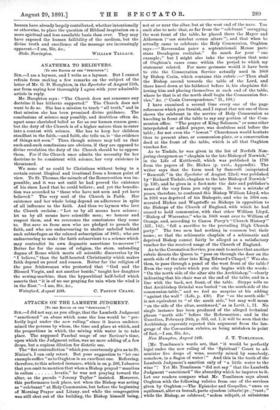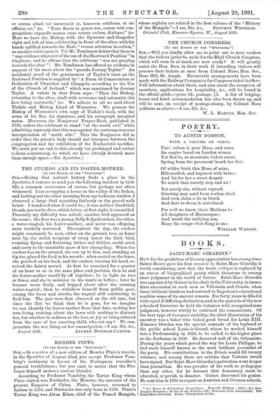ATTACKS ON THE LAMBETH J U GME N T.
[TO THE EDITOR OP THE "SPECTATOR."] SIR,—I did not say, as you allege, that the Lambeth Judgment " sanctioned " an abuse which none the less would be " per- fectly legal under the new ruling," since it leaves undeter- mined the persons by whom, the time and place at which, and the proportions in which, the mixing with water is to take place. The supposed Paschal usage of our Saviour's time, upon which the Judgment relies, was no mere adding of a few drops, but a copious dilution for dietetic use.
The "flat contradiction " which you courteously give as to St. Ninian's, I can only retort. But your suggestion to " let one example suffice "as to 0 ughton is an excellent one. Referring, therefore, to this selected instance, which is on p. 266, I observe that you omit to mention that when a Bishop prayed " mani bus in ccelum levatis," he was not praying toward the altar, as the pseudo " Jeremy Taylor " insisted. Moreover, this performance took place, not when the Bishop was acting as " celebrant" at Holy Communion, but before the beginning of Morning Prayer and Litany, and while the congregation was still shut out of the building, the Bishop himself being,
not at or near the altar, but at the west end of the nave. You omit also to note that, so far from the " celebrant " occupying the west front of the table, he placed there the Mayor and Aldermen (" eos sistebat coram altare "), and that when he actually came to celebrate the Holy Communion, Oughton says :—" Reverendus pater a septentrionali Mensaa parte titans Decalogum recitabat." So much for your " one example ;" but I might also take the exception that none of Oughton's cases come within the period to which my statement related. Far more germane would it have been to cite the Consecration Service actually used in 1668 by Bishop Cosin, which contains this rubric :—" Then shall the Bishop ascend towards the table of the Lord, and there kneel down at his faldstool before it, his chaplains fol- lowing him and placing themselves at each end of the table, where he that is at the north shall begin the Communion Ser- vice," &c. (" Cosin Correspondence," II., 188.)
I have examined a second time every one of the page- references which you furnish, and I repeat that not one of them shows the celebrant in the service of Holy Communion as kneeling in front of the table to say any portion of the Com- munion office. "The prayer of King Solomon," or some other interpolated or added prayer, was doubtless said before the table ; for not even the " lowest " Churchman would hesitate thus to present alms, or communion-plate, or a consecration deed at the front of the table, which is all that Oughton vouches for.
As to Tisdale, he was given in the list of Norfolk Non- j uring clergymen as "chaplain to the late Bishop of Norwich," in the Life of Kettlewell, which was published in 1718• from the papers of Dr. Hickes (p. xxvi., Appendix). The writer says that the form used by Sancroft (misprinted. " Bancroft " in the Spectator of August 22nd) was published by " Richard Tisdale, chaplain to the late Bishop of Norwich" (p. 139), and he gives in a foot-note the date and publisher's name of the very form you rely upon. It was a mistake of yours, therefore, to confound this Bishop William Lloyd, who in 1691 was deprived of his Bishopric, and who in 1694 con- secrated Hickes and Wagstaffe as Bishops in opposition to the Bishops of the Church of England, with which he had ceased to hold communion, with that other William Lloyd, "Bishop of Worcester," who in 1668 went over to William of Orange, and, according to Canon Perry's " Church HistorY "
142), "fell a sacrifice to the prevailing High Church party." The two men had nothing in common but their name; so that the schismatic chaplain of a schismatic and deprived Bishop cannot fairly be alleged as a satisfactory voucher for the received usage of the Church of England.
As to the Coronation Service, you omit to notice that another rubric directs the Queen to "pass on through the door on the south side of the altar into King Edward's Chapel." Was she, then, to pass through a panel of the west front of the table P Even the very rubric which you cite begins with the words : "On the north side of the altar sits the Archbishop,"—clearly indicating that his chair was at the end of the table, and in a. line with the back, not front, of the table. Strype tells 118 that Archbishop Grindal was buried "on the south side of the communion-table," and we feel no surprise at his adding " against the wall " (Life, p. 430). For " on the south side " is not equivalent to " at the south side," but may well mean "on the side of the altar, southward," as in Levit. i., 11. No single instance has been produced of the alleged technical phrase "north side" before the Reformation ; and in the Guardian, February 26th, p. 353, col. 1, it will be seen that the Archbishop expressly rejected this argument from the lan- guage of the Coronation rubrics, as being mistaken in point of fact.—I am, Sir, &c., [Mr. Tomlinson's words are, that "it would be perfectly legal under the new ruling of the `Spiritual' Court to ad- minister five drops of wine, secretly mixed by somebody,. somehow, in a flagon of water !" And this in the teeth of the Lambeth Judgment's sanction only of "a little water to the "! Yet Mr. Tomlinson " did not say " that the Lambeth Judgment "sanctioned" the absurdity which he imputes to it.. Let our readers compare what Mr. Tomlinson says about Oughton with the following rubrics from one of the services given by Oughton :—The Epistoler and Gospeller, "onus es aquilonari, alter ex boreali, parte ejusdem (altaris) pi\ -*rant; " while the Bishop, as celebrant, "sedem reliquit, et subsistens.
se coram altari ter incurvavit se, honorem exhibens, et sic affatus est," &c. " Tune flexus in genua sua, coram tots', con- gregatione expandit mantis suas versus ccelum, dixitque," &c. Here we have the Bishop, with the Epistoler and Gospeller right and left of him, celebrating in front of the altar, with his hands uplifted towards the East, "versus orientem in ccelum," as another rubric puts it. Yet Mr. Tomlinson denies that there is " any evidence whatever of the use of the Eastward Position "in Oughton ; and he affirms that the celebrant " was not praying towards the altar " ! Mr. Tomlinson has offered no evidence in support of his sneer about the "pseudo Jeremy Taylor." An incidental proof of the genuineness of Taylor's tract on the Eastward Position is supplied by " A Form of Consecration or Dedication of Churches and Chappels, according to the Use of the Church of Ireland," which was sanctioned by Jeremy Taylor. A rubric in that Form says: " Then the Bishop, returning to the altar, shall with reverence and solemnity (his face being eastward)," &c. We adhere to all we said about Tisdale and Bishop Lloyd of Worcester. We possess the Bishop of Worcester's own copy of Tisdale's book, with the arms of his See, his signature, and his autograph marginal notes. Moreover, the Nonjurors' Prayer-Book, published in 1718, orders the celebrant to stand " at the north end," while admitting expressly that this was against the contemporaneous interpretation of "north side." This the Nonjurors did in order that the priest's body should not interpose between the congregation and the exhibition of the Eucharistic sacrifice. We must put an end to this already too prolonged and rather tedious controversy, to which we have already devoted more than enough space.—En. Spectator.]



































 Previous page
Previous page